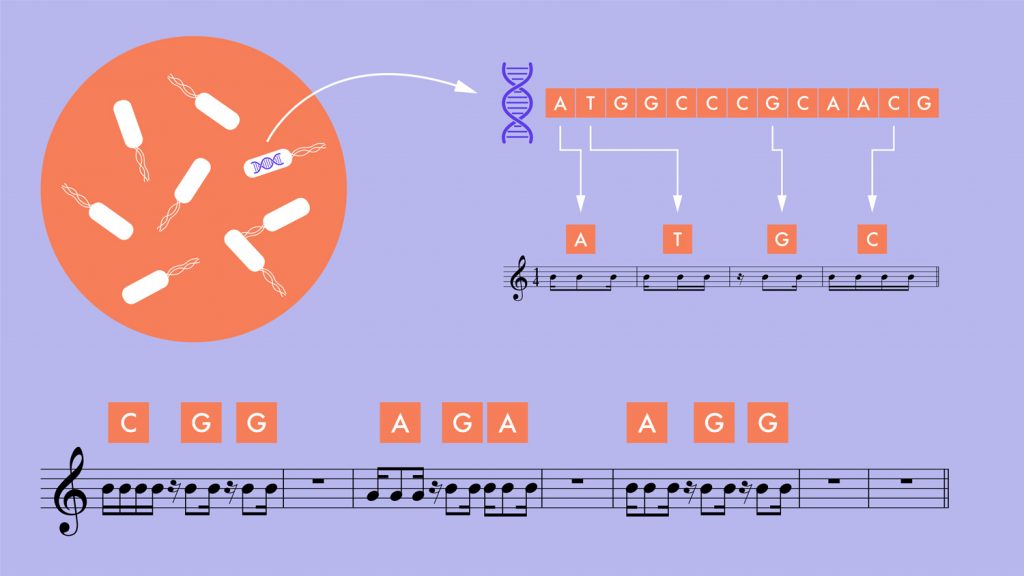PRESS RELEASE If you could listen to the DNA in your genes, how would it sound like? This question stood at the beginning of the groundbreaking collaboration between a musical composer and a microbiologist, and the answer to that question is now online and available to the public.
Eduardo Miranda, a composer from the University of Plymouth, UK, worked with Pablo I. Nikel, a metabolic engineer from the Novo Nordisk Foundation Center for Biosustainability, Denmark, to create a musical representation of a particularly exciting metabolic process called biofluorination. Fluorine is an element hardly used in living organisms, so all the many objects in our daily life that contain fluorine (such as electronics, cookware, and even raincoats) are produced chemically, under harsh and toxic conditions. In order to produce these fluorine compounds in a safer and more sustainable manner, Pablo and a team of researchers and companies of the European Horizon 2020 project “SinFonia” want to genetically enhance bacteria to build these compounds biologically. The most challenging part is to look at the cell in a holistic manner and to coordinate the different genetic and metabolic elements so biofluorination can take place. The whole process is reminiscent of a musical composition, so it was only natural to invite Eduardo to Pablo’s laboratory for an art-science collaboration.

The SinFonia composition with its translation of complex enzyme interactions into a musical language is now available on SoundClick:
“Interacting with Eduardo has been an eye-opening experience for my team and myself – we established a dialogue blending science and art beyond any barrier or prerogative, and learned much from each other. From my personal perspective, this experience had been a perfect fit for SinFonia, where we ‘compose’ novel chemistries in cell factories – and Eduardo has shown how chemistry can lead to music, too!” said Pablo I. Nikel.
Miranda created the Genetic Musinator System where he translates DNA sequences into musical amino acids that are expressed in terms of musical codon sequences (codons are genetic sequences that correspond to specific amino acids). He took the DNA of six enzymes necessary for biofluorination (fluorinase, nucleosidase, kinase, isomerase, aldolase, and aldehyde dehydrogenase) and fed them into the Genetic Musinator System, which also produced mutations. The original enzymes and the mutations generated various tracks of music which were mixed to generate six short compositions, one for each of the enzymes, and joined in a complex piece.
“It was very interesting to learn how the SinFonia team is developing methods to produce new fluoro-chemicals biologically. I realized that the ways in which this can be done resonate with the ways in which I compose music. This inspired me to design a system to generate music informed by biological processes,” elaborated Miranda on the collaboration.
Eduardo worked with Manuel Nieto and Nicolas Krink in Pablo’s team in this quest of music-from-biochemistry. The composition tells a metaphorical story, whereby the six musical enzymes interact with one another to form a chain of musico-chemical reactions, representing the process of biofluorination. The piece begins with nucleosidase, when aldehyde dehydrogenase enters the scene. While these two ‘react’, a new element appears in the mix: aldolase. These three enzymes somehow give room for the appearance of isomerase. Subsequently kinase emerges and the rhythms become confusing: it is a bio-chemical storm. Finally, it is time for the melodic and charming fluorinase to enter the scene and to consolidate the biofluorination process with a soothing piano melody.
The SinFonia composition with its translation of complex enzyme interactions into a musical language is now available on SoundClick.
About SinFonia:
SinFonia is a 4-year long EC funded research project (2019-2022) with 12 academic and industrial partners from across Europe and a total budget of 7,94 Mio €. One part of the project is an artist in residency program, facilitated by Biofaction, which allows a direct collaboration between artists and researchers. More information can be found at www.sinfoniabiotec.eu.